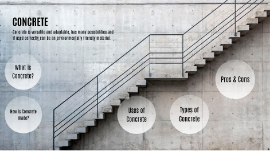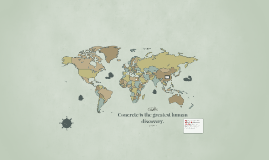Concrete Presentation
Transcript: Concrete is versatile and adaptable, has many possibilities and if used correctly can be an environmentally friendly material. CONCRETE What is Concrete? What is Concrete? A heavy building material made from a mixture of broken stone or gravel, sand, cement, and water, that can be spread or poured into molds and that forms a stone like mass upon hardening. “Concrete in architecture.” David Report, 8 Feb. 2013, davidreport.com/201302/con/. Strong and Durable Versatile Low maintenance Affordable Fire-resistant Acts as a thermal mass Locally produced and used Reflective Low lifecycle CO2 emissions Properties of Concrete Properties of Concrete How is Concrete made? How is Concrete made? Materials: Concrete is made from water, sand, aggregates and cement. Step One: Materials are combined in a mixer that utilizes a revolving drum to keep the ingredients constantly moving. Concrete can also be mixed by hand in much smaller quantities. Step Two: It is then poured from the mixer into its mold, where it cures and forms a solid, durable material. http://ieltsliz.com/ielts-diagram-model-answer-score-9/ Materials Materials Photo Courtesy of: Portland Cement Association Aggregate is a critical component to concrete. It is a mix of ground up stones, gravel, slag, recycled concrete and geosynthetic aggregates. Aggregates of various mixtures and sizes are used to keep the concrete durable, reduce shrinkage and change the properties of the finished concrete. Aggregate Aggregate http://www.greenspec.co.uk/building-design/aggregates-for-concrete/ Refers to size of aggregate Determines the properties of the concrete Poorly graded concrete needs more cement to fill in the gaps and is less economical Aggregate Gradation Aggregate Gradation Photo Courtesy of: Concrete Countertop Institute Contrary to common belief, concrete and cement are not the same material; cement is an ingredient within the concrete. Cement acts as a binding agent within the concrete. The most commonly used cement is Portland cement, which is created by the heating and grinding of lime, silica, iron and alumina. Cement Cement http://www.lafargeholcim.com/cement-solutions Water plays a very important role in concrete. It determines the strength and placeability of the mixture. Less water=higher strength, but more difficult to place More water=less strength, but easier to place The amount of water added often varies due to the concrete's use. Water Water https://www.ioes.ucla.edu/event/spotlight-sustainability-preparing-company-water-resiliency/ Sand that is used in concrete is typically quartz sand, which is found in forests and river beds. The tearing up of forests for this sand has caused great environmental issues. Sand is used in many products and is currently in a state of shortage. Countries are banning its export and forming black markets for its trade. One solution would be to replace sand with ground up rock, but it is a highly expensive and poor quality option. Sand Sand https://www.indiamart.com/memon-minerals-gandhinagar/ Admixtures can modify the properties of hardened concrete. Admixtures can be anything from pigments, expansive agents, and pumping aids. They usually come in liquid form and can be added to the concrete mix. There are 5 main classes of chemical admixtures: air-entraining, water-reducing, retarding, accelerating, and plasticizers. Admixtures Admixtures Uses of Concrete Uses of Concrete Roman Concrete: The Romans mixed lime and volcanic ash together to form a mortar. How did they do it: Hand mixed wet lime with volcanic ash in a mortar box. Little water was used to create a nearly dry mixture. This composition was carried to the job site in baskets and placed over a prepared layer of rock pieces. Mortar was then pounded into the rock pieces. https://www.youtube.com/watch?v=tOhAfaFboNU Historic Historic One of the greatest examples of the strength of Roman concrete is the Pantheon built in 27AD. Case Study Case Study Shawn, Norris “Pantheon (#3).” Rome Across Europe, 14 Mar. 2017, www.romeacrosseurope.com/?p=7047#sthash.2c8ckyqz.dpbs. Typical uses of concrete today: Buildings: foundations flooring walls countertops stairs gutter applications columns patios Public Transportation: driveways pavement curbs/sidewalks parking lots Other Uses: drainage piping swimming pools bridges dams skyscrapers Current Current Jubilee Church-Rome, Italy designed by American architect Richard Meier Meier won a contest against Frank Gehry, Tadao Ando and others for the design 27,000 square foot church constructed of white, precast concrete walls and glass distinct feature is three curved walls, inspired by sails of a ship Case Study Case Study http://www.richardmeier.com/?projects=jubilee-church-2 http://homesthetics.net/iconic-modern-architecture-jubilee-church-in-rome-by-richard-meier-and-partners/ Pulitzer Arts Foundation-St. Louis, Missouri designed by Japanese architect Tadao Ando first public building designed by Ando in North America showcases Ando's

















